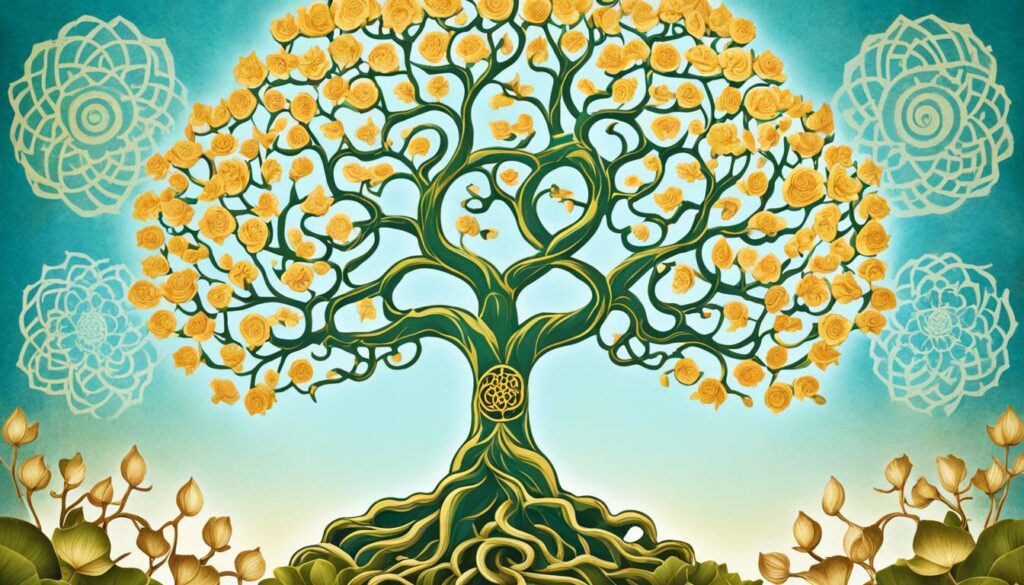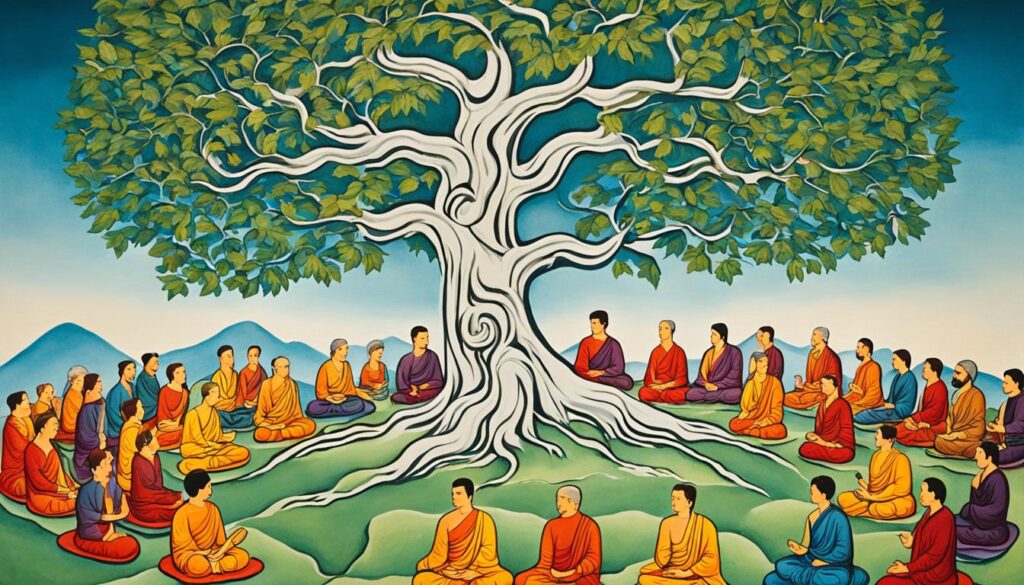“The mind is everything. What you think you become.” – Buddha
Welcome to the world of Buddhism, where the followers of Gautama Buddha seek enlightenment and inner peace. Buddhism is a major global religion that has influenced the lives of millions of individuals for centuries. If you’ve ever wondered what the followers of Buddhism are called, you’ve come to the right place. In this article, we will explore the community of Buddhist practitioners, their beliefs, and the path they follow to achieve personal and societal harmony.
Key Takeaways:
- Buddhists are the followers of Buddhism, a major world religion.
- Buddhism was founded by Siddhartha Gautama, also known as the Buddha.
- The path of Buddhism focuses on achieving enlightenment and inner peace.
- Buddhism has a serene community of practitioners who follow the teachings of Gautama Buddha.
- Buddhism is considered one of the largest religions in the world, with an estimated 500 million to one billion followers.
The Noble Eightfold Path: A Spiritual Journey towards Liberation
The Noble Eightfold Path is a fundamental aspect of Buddhist teachings that serves as a transformative guide for practitioners seeking liberation from the cycle of rebirth, known as samsara. As one of the core teachings of Buddhism, the path encompasses eight right practices that lead to enlightenment and the ultimate attainment of nirvana.
The Eight Right Paths:
- Right View: Developing an understanding of the true nature of existence and the Four Noble Truths.
- Right Resolve: Cultivating wholesome intentions and aspirations that are aligned with compassion, generosity, and wisdom.
- Right Speech: Practicing truthful, kind, and non-harmful communication, avoiding gossip, divisive, and harsh language.
- Right Conduct: Engaging in actions that are ethical, respectful, and considerate towards oneself and others.
- Right Livelihood: Choosing an occupation or livelihood that does not cause harm to oneself or others, such as avoiding jobs involved in weapons, intoxicants, or unethical activities.
- Right Effort: Cultivating the effort to abandon unwholesome qualities, develop wholesome qualities, and maintain a positive and focused mindset.
- Right Mindfulness: Developing attentive awareness in the present moment, observing the body, feelings, mind, and mental phenomena with non-judgmental acceptance.
- Right Samadhi: Cultivating deep concentration and meditative absorption, allowing the mind to become still and focused, leading to insight and liberation.
These eight paths, when practiced diligently, simultaneously nurture morality, meditation, and wisdom. They offer a holistic approach to spiritual growth, empowering Buddhist practitioners to attain liberation from the suffering inherent in samsara and pave their way towards enlightenment.

Beliefs and Practices of Buddhism
Buddhism encompasses a set of beliefs and practices that revolve around the concept of suffering and its causes. Buddhists strive to achieve enlightenment and experience nirvana, focusing on personal growth and spiritual development. The founder of Buddhism, Siddhartha Gautama, also known as the Buddha, is revered as an extraordinary being but not as a god.
The path to enlightenment in Buddhism is marked by the Four Noble Truths, which serve as the foundation of Buddhist philosophy. These truths state that suffering exists, suffering arises from attachment and desire, suffering can cease, and there is a path to end suffering and attain enlightenment.
- The First Noble Truth: The truth of suffering – Life is filled with pain, dissatisfaction, and unsatisfactoriness. Buddhists recognize suffering as an inherent part of human existence.
- The Second Noble Truth: The truth of the origin of suffering – Attachment and desire lead to suffering. Buddhists understand that craving and attachment to material possessions, relationships, and worldly pleasures perpetuate the cycle of suffering.
- The Third Noble Truth: The truth of the cessation of suffering – By letting go of attachment and desire, suffering can be overcome. Buddhists believe that through the cessation of craving, enlightenment and liberation can be achieved.
- The Fourth Noble Truth: The truth of the path to the cessation of suffering – The Noble Eightfold Path is the path to end suffering and attain enlightenment. It consists of eight interconnected practices that encompass morality, meditation, and wisdom.
Buddhism places great emphasis on karma, the law of cause and effect. Buddhists believe that our actions have consequences that create our present circumstances and can influence future lives through the cycle of rebirth. Through the practice of meditation and mindfulness, Buddhists aim to cultivate awareness and develop insight into the nature of reality.

Buddhist symbols hold deep meaning and represent various aspects of Buddhist beliefs and teachings. Some of the most common Buddhist symbols include:
- The Lotus Flower: Symbolizes purity, enlightenment, and the ability to rise above challenging circumstances.
- The Dharma Wheel: Represents the teachings of the Buddha and the Eightfold Path. It signifies the continuous cycle of life and the path to liberation.
- The Bodhi Tree: Signifies the place where Siddhartha Gautama attained enlightenment. It represents wisdom, spiritual growth, and the potential for awakening.
- The Swastika: In Buddhism, the swastika symbolizes auspiciousness, good fortune, and the endless cycle of life, death, and rebirth.
In Buddhism, followers strive to embody the principles of compassion, wisdom, and mindfulness in their daily lives. By cultivating these qualities and adhering to the teachings of the Buddha, Buddhists endeavor to attain enlightenment and experience the ultimate liberation from suffering.
The Life and Teachings of Siddhartha Gautama
Siddhartha Gautama, later known as the Buddha, was the founder of Buddhism. He was born into a wealthy family in present-day Nepal during the 5th century BCE. Despite living a life of privilege and luxury, Siddhartha felt deeply moved by the suffering he observed in the world. This realization led him to renounce his comfortable lifestyle and embark on a spiritual quest to discover the meaning of life and find a way to alleviate human suffering.
For years, Siddhartha dedicated himself to intense meditation, seeking enlightenment and the path to liberation. Finally, while meditating under a Bodhi tree, he achieved a state of profound awakening and realized the truth about existence and the cessation of suffering. This transformative experience marked the birth of Buddhism, as Siddhartha became the Buddha, which means “awakened one” or “enlightened one.”
From that point forward, the Buddha devoted the rest of his life to sharing his teachings with others. His profound insights into the nature of reality, the causes of suffering, and the path to enlightenment formed the foundation of Buddhism. Known as the Dharma, these teachings emphasized wisdom, compassion, and the Middle Way, a balanced approach to life that avoids extremes.
The Buddha’s teachings continue to guide millions of people around the world on their own paths to awakening and liberation. His example of compassion, wisdom, and self-discovery serves as an inspiration for all who seek to find meaning, peace, and enlightenment in their lives.

Key Teachings of the Buddha
| Teaching | Description |
|---|---|
| The Four Noble Truths | The truth of suffering, the causes of suffering, the cessation of suffering, and the path to the cessation of suffering. |
| The Noble Eightfold Path | Right view, right intention, right speech, right action, right livelihood, right effort, right mindfulness, and right concentration. |
| Karma | The law of cause and effect, which states that our actions have consequences that shape our future experiences. |
| Rebirth | The belief in the continuous cycle of birth, death, and rebirth, influenced by one’s actions in previous lives. |
Conclusion
Buddhism offers a serene and peaceful path for its followers to embrace. Through the teachings of the Noble Eightfold Path and the understanding of suffering through the Four Noble Truths, Buddhism provides profound insights into personal and societal harmony.
As followers of Buddhism, known as Buddhists, you strive to achieve enlightenment and experience nirvana. By practicing morality, meditation, and wisdom, you actively work to alleviate suffering and cultivate compassion for all living beings.
The influence of Buddhism extends far beyond East and Southeast Asia, with its teachings gaining popularity in the Western world. By embarking on a journey to explore Buddhism, you embark on a spiritual quest to find guidance for your own path towards peace and enlightenment.
Embrace your path with Buddhism, for it offers a profound philosophy and practical framework that can transform your life and bring harmony to the world. Discover the teachings of the Buddha, follow the Noble Eightfold Path, and join the ever-growing community of Buddhists in their pursuit of awakening and liberation.
FAQ
What are the followers of Buddhism called?
The followers of Buddhism are called Buddhists.
What is the Noble Eightfold Path?
The Noble Eightfold Path is a collection of eight practices in Buddhism that lead to liberation from the cycle of rebirth and ultimate nirvana.
What are the beliefs and practices of Buddhism?
Buddhism revolves around the concept of suffering and its causes. Buddhists focus on achieving enlightenment and experiencing nirvana through morality, meditation, and wisdom.
Who was Siddhartha Gautama?
Siddhartha Gautama, later known as the Buddha, was the founder of Buddhism. He renounced his luxurious lifestyle and dedicated his life to teaching others about the path to enlightenment and the cessation of suffering.
What is the conclusion of Buddhism?
Buddhism offers a serene and peaceful path for followers to embrace. By practicing morality, meditation, and wisdom, Buddhists seek to alleviate suffering and cultivate compassion for all living beings.

